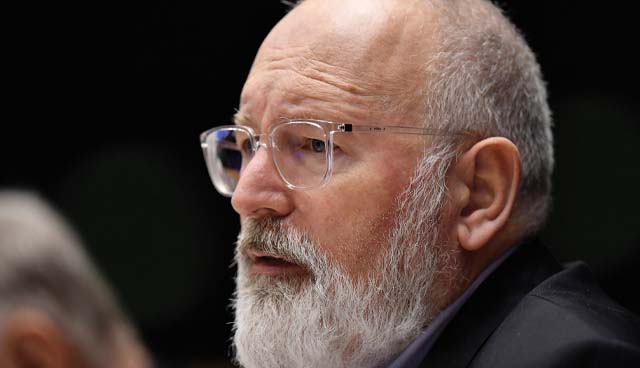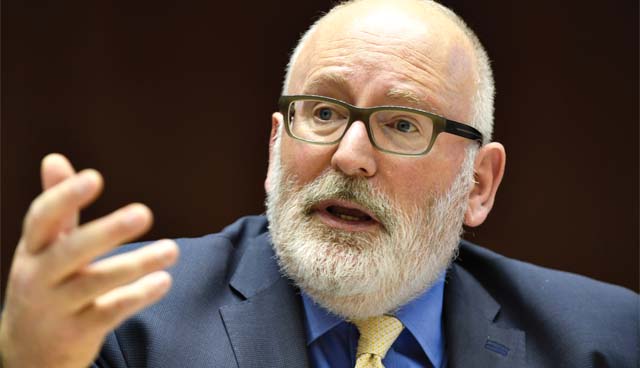Frans Timmermans: Fit for 55

Following the European Union’s move to enshrine a 55 per cent emissions reduction in the new European Climate Law, Executive Vice President of the European Green Deal Frans Timmermans discusses the measures which will be required to achieve this.
Timmermans, the former Dutch Minister for Foreign Affairs and first Vice-President of the European Commission has led the Commission’s work on the European Green Deal and its first European Climate Law to enshrine the 2050 climate-neutrality target into EU law.
He expresses not only a sense of urgency on the collective need to act to address climate change but also the role of every citizen in making the necessary emission reductions.
“The good news is that if we commit to transformation then we can do so convincingly. The bad news is that if we are divided, if we are not convinced and if we feel others should be doing more while we are doing less then we will not limit the rise in temperature to below 2ºC.”
Pointing to the evident effects of global warming across the planet on the form of droughts, floods and erratic weather patterns, Timmermans’ says that of equal importance is addressing the biodiversity crisis which is putting one million species at risk of being lost. He also believes “beyond any doubt” that the Covid-19 pandemic is linked to the biodiversity crisis, stating a lack of distance to our natural environment means that viruses usually “absorbed by our natural environment” now reach humanity “almost immediately”.
The Vice-President says that fundamental to correcting these challenges is the lesson that “humanity must live within the boundaries that our planet sets us”. “That means changing almost everything,” he states.
Highlighting the European Green Deal as a basis for change, Timmermans’ says that work with member states on recovery plans has combined efforts to move out of the crisis, embrace the opportunities of the industrial revolution and confront the climate crisis and the risk of ecocide.
“The European Green Deal offers a clear path to climate neutrality by 2050 and gives a clear indication of what needs to be done between now and then, in way that is feasible.”
“We need to reduce the free allowances under ETS and evaluate its scope, enlarging it in different sectors.”
Timmermans’ warns against delaying climate action to the later decades, believing that such change will be too radical for society to accommodate. “If we start now, and I mean that literally, we can reduce our emissions step by step to reach climate neutrality by 2050”, he adds.
The Executive Vice-President says that a scientifically informed need to “up the ante” was the driving force behind the lifting of ambitions from a 40 per cent reduction by 2030 to a 55 per cent reduction, now enshrined in law. Added to this, Timmermans explains that a coupling of Europe’s 60 per cent economic increase in the past two decades alongside a 20 per cent decrease in emissions is demonstratable proof that emission reduction can be done in tandem with economic growth.
However, he is aware that achieving a 55 per cent reduction by 2050 will require further measures, included in the EU’s Fit for 55 package.
Outlining some of these, he points to a need to reform and strengthen the emissions trading system (ETS). The ETS has been a successful method of putting a price on carbon to the point where others, including China, are now considering a similar system introduction.
“The ETS is working well, and the markets expect it to continue functioning well, but we need to strengthen it. We need to reduce the free allowances under ETS and evaluate its scope, enlarging it in different sectors,” he says.
Added to this is a planned revision of the effort sharing regulation on member states’ reduction targets in sectors outside the ETS.
On a planned revision of the regulation on the inclusion of greenhouse gas emissions and removals from land use, land use change and forestry (LULUCF), Timmermans’ estimates that 75 per cent of Europe’s forests are “in a bad state”. An increase in the area of forestry across Europe has not been matched with an increase in carbon sink, which he describes as a “serious problem”. The Climate Law forces an increase in the carbon sink and this obligation was core to the creation of the EU’s recent Forest Strategy for 2030.
EVs
The Fit for 55 package also includes plans for an amendment of the regulation setting CO2 emission standards for cars and vans. Timmermans believes the move towards EVs across Europe is going faster than expected but says that greater strictness on emission standards would stimulate the production of EVs, which he says is necessary to decreasing the price per unit.
“There are two things currently preventing people switching to EVs: The price today, which I think will be very different in five years’ time, and the lack of charging infrastructure. We need to stimulate both very quickly at EU level and at national level,” he states.

“We need to make sure we give farmers a better, stronger future and that we also reward them for being carbon farmers and for being custodians of our natural environment.”
One of the most debated measures of the package is the planned introduction of a carbon border adjustment mechanism, equalising the price of carbon between domestic products and imports and preventing the risk of carbon leakage. Timmermans says that discussion with international partners around the mechanism has been positive, as it has highlighted the need for others to move towards climate neutrality to avoid protective measures at the borders. Even prior to implementation, the prospect of a mechanism has stimulated development in the right direction.
Discussing plans to revise the energy tax directive, Timmermans says: “We will need to renew energy taxation, including to reduce the scope of fossil fuel subsidies. The price decrease and profitability of renewable energy was always underestimated, and I believe if you look at what is happening in relation to renewable technology then I believe we will no longer need investments in fossil fuels.
“We need direct EU financial support for decarbonisation, and we need to improve the enabling conditions, including the action plan on financing sustainable growth and the EU taxonomy regulation for green investments. We also need to look very carefully at state aid rules to ensure that they are in line with the needs and objectives of the Green Deal and the climate neutrality objective.
“I believe that this is a strategy not only to get us in line with our climate commitments but also to get us on a growth path in the new economy and to living within our planetary boundaries.”
Ireland
Focusing specifically on Ireland, Timmermans says that domestic policy has gone some way to addressing a recognisable need for Ireland to “catch up” in relation to emissions reduction. The Executive Vice President believes it will be essential for the Government to work with farmers in relation to mitigation policies, given the scale of the beef and dairy sectors in the country.
“Let me be very clear, farmers are the solution,” he states “And we should help them along, but they cannot continue along the lines of the traditional Common Agricultural Policy (CAP), when you consider the impact on our biodiversity.
“We need to make sure we give farmers a better, stronger future and that we also reward them for being carbon farmers and for being custodians of our natural environment.”
Saluting Ireland’s move to end the extraction of peat for energy and horticulture, while restoring peatlands, he says: “I think that’s an excellent example of the just transition that the Green Deal can offer.”
Finally, Timmermans says that the progress of the Climate Action and Low Carbon Development (Amendment) Act 2021 is a major step forward by placing a strong framework for climate action.





